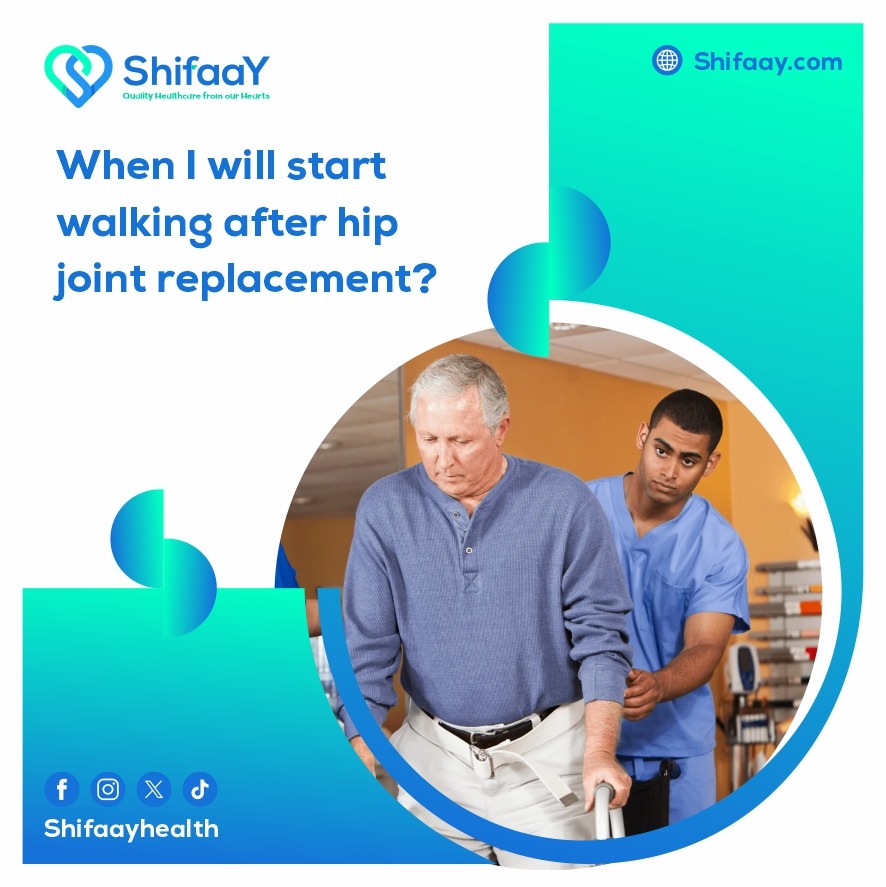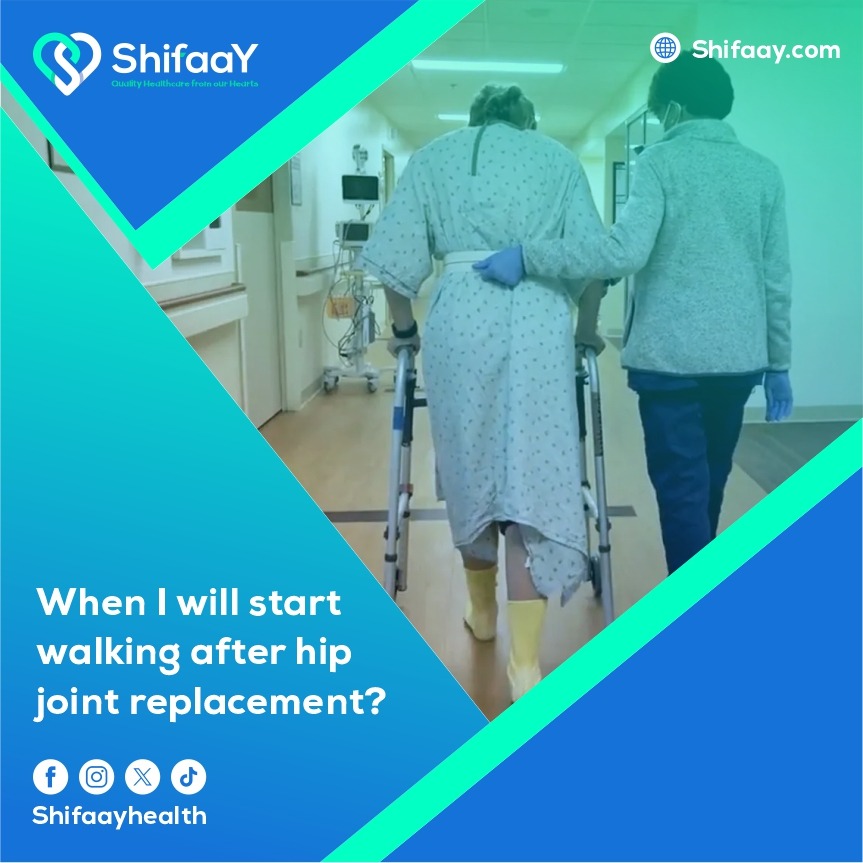Walking after hip replacement surgery
When does walking start after hip replacement? This is the question that many patients with severe thigh pain wonder about when they decide to undergo this life-saving, highly effective surgery that aims to improve their mobility and quality of life. The placement of a hip joint is one of the most significant surgical procedures; its proper execution always demands a great deal of experience and skill. This recovery period is critical to the procedure’s outcome and the patient’s comfort; it also determines when the patient is ready to resume walking following the surgery, which may expedite recovery and reduce complications.
It should be mentioned that after hip replacement surgery, the patient goes straight into the recovery phase. This means that the patient needs to be closely monitored and given extra care by doctors and specialists who have a lot of experience and training in the field, like those at the Shifaay Center. It should be noted that patients often begin walking slowly after hip replacement the day after surgery or within a few days, depending on their condition and the directions and advice of the treating doctor. The goal of this is to reduce the risk of blood clots and enhance blood flow to the surgical area, which contributes to accelerating the healing process and improving the quality of life. This step is typically completed with the aid of assistive technology, which can provide stability and the required psychological support, such as crutches, a walking walker, etc.
As time passes and the healing process progresses, physical activity may be gradually increased under the supervision of physical therapy specialists. Physical therapy sessions are essential and vital in teaching the patient how to walk after the hip joint replacement is correctly installed using the new joint. It also aids in the restoration of flexibility and natural movement, strengthening the surrounding muscles. These qualities could help to optimize outcomes and hasten the process of regaining the ability to walk naturally. A patient’s recovery time may differ from another’s depending on a number of critical variables, including age, overall health, and how closely the patient follows physical therapy recommendations.
Walking after hip replacement

Hip replacement surgery is one of the major surgical procedures that always requires the highest level of medical care, along with extra attention after the procedure to ensure a full and speedy recovery and walking after hip replacement surgery is one of the most crucial essentials advised by the doctors at Shifaay Center. Walking is one such practice that is particularly effective in helping patients quickly regain their strength and health. It is important for regaining wellness and enhancing the healing process because the recovery process is crucial during the post-surgical phase, and its success primarily depends on adhering to medical advice and reputable health practices.
Walking after hip replacement surgery is one of the crucial exercises that greatly improves blood circulation and lowers the risk of blood clot formation, which is one of the possible side effects of surgery. This is one of the most famous techniques for reducing stress and pain perception, and it also improves psychological states and moods, so it might be an essential step in the healing process.
Furthermore, walking after hip replacement surgery is one of the most important steps in ensuring full recovery to ensure safety and well-being, following the guidelines set forth by medical professionals. Our center’s doctors always recommend starting with short walks and gradually increasing the duration based on the patient’s response and the capacity of the medical condition. They also advise wearing supportive, comfortable shoes to prevent excessive pressure on the pelvic area. Finally, always consult a doctor before beginning any physical activity, as this forms the basis for any post-surgery steps the patient takes.
Also follow: The cost of shock wave therapy in Egypt
Walking method after joint replacement surgery
Without a doubt, hip replacement surgery is one of the crucial surgical procedures that helps a lot of people get back to living normally and improve their quality of life. The true success of this procedure, however, may well hinge on how the postoperative recovery phase is managed. The most important component of this phase is learning to walk once the hip joint is installed soundly and correctly in order to avoid complications and side effects. Reputable medical experts who specialize in this field consistently advise walking gradually because it is one of the basic strategies that helps to accelerate healing and improve recovery.
In addition, walking after installing the hip joint is one of the important vital activities that always helps improve blood circulation and prevent the formation of blood clots. This is in addition to strengthening the muscles surrounding the new joint, enhancing mobility, etc. Walking after hip replacement surgery may involve: walking short distances at first, then gradually increasing them in compliance with the treating doctor’s instructions; initially using crutches or other walking aids to support weight and prevent undue strain on the recently repaired joint. It is also recommended to conduct physical therapy sessions as it is one of the basic parts of the procedure. The rehabilitation process may require regular performance of the exercises prescribed by the Shifaay Center physical therapist in order to achieve remarkable medical outcomes. This may include walking with proper alignment of the body and avoiding sudden movements or physically demanding activities that could result in damage to the newly formed joint.
It is noteworthy that patients must understand that recovering from hip replacement surgery may call for a great deal of endurance and dedication, as there may be numerous obstacles to overcome at first. However, with the right training and the passage of time, walking after hip replacement surgery becomes more comfortable and easier. And in order for this to be accomplished, the highly qualified medical professionals at our facility advise you to make follow-up appointments on a regular basis to check on the condition and make sure there are no complications. They also advise you to be cautious to always listen to your body and stay within recommended bounds to prevent unintentional harm or complications.
It can be generally stated that following medical advice and guidelines is essential to a full recovery and a return to an active and productive life following joint replacement surgery.
Exercises after hip replacement surgery
Hip replacement surgery is one of the most important procedures that consistently and successfully improves the quality of life for a great number of people who have chronic pain that flares up occasionally and difficulty moving around. As a result, following this procedure, doctors may advise patients to commit to doing specific exercises, as they are a fundamental and significant part of the healing process and the process of returning to normal activity. The healing process following hip replacement surgery always starts the moment the patient wakes up from the procedure and includes basic breathing and strengthening exercises as well as simple movements like bending and gently moving the ankle.
Specifically, exercise is one of the most important things that can be done after hip replacement surgery to keep the muscles around the new joint active and prevent stiffness. To ensure that the exercises are performed correctly and prevent unnecessary pressure on the joint, it may be necessary to work with a professional physical therapist with experience in this field, such as the best physical therapist at the Shifaay Center. It should be noted that as the healing process progresses and patients have more time to recover, they may be able to gradually increase their exercise regimen to include balance and muscle strengthening exercises like sitting and standing exercises and straight leg raises. These exercises not only help to improve the range of motion and flexibility in the newly formed hip joint, but they also strengthen the surrounding muscles and increase overall body stability. All of these benefits help patients perform activities more easily and safely.
In addition, later post-hip replacement exercises might include more challenging exercises such as walking on uneven surfaces following hip joint replacement and some light weight resistance exercises. These exercises might ensure complete function recovery, muscle strengthening, and improved flexibility and stability. It might be advisable to carry out these exercises under PT supervision to guarantee correct execution and avoid any complications. Aerobic exercises can also be very important at this point because they help improve cardiovascular health and overall physical fitness, which enables the patient to resume an active, healthy life free from pain and restricted movement.
Tips after hip replacement surgery
We must keep in mind that hip replacement surgery has become one of the major surgical operations that always requires a long time to fully recover. Here are a few of the most crucial pointers and guidelines that can help patients have a better quality of life, recuperate from surgery more quickly, and be able to walk more easily and swiftly after hip replacement. These tips are as follows:
- First, following hip replacement surgery, the patient may need to carefully follow all instructions from the treating doctor. He must also adhere to taking prescribed medications regularly to avoid any possible complications and control pain.
- Second, it is advised that the patient fight the urge to give in to exhaustion and start moving and walking gradually under the supervision of one of the skilled specialists on staff at the Shifaay Center, which is recognized as the best Center for Medical Tourism.
- Thirdly, it is advised to perform some basic motions and physical therapy exercises, as these can significantly and effectively prevent blood clots and improve blood circulation, both of which can aid in the healing process.
- Fourth, the patient should follow the directions regarding medication and mobility. They should also pay close attention to their diet following the procedure, consuming foods high in wholesome proteins, vitamins, and minerals, as these nutrients promote tissue growth and the healing process.
- Fifth, it is advised to stay away from foods high in fat and sugar as they may impede the healing process and raise the chance of infections.
- Sixth, consuming enough water is advised to keep the body properly hydrated, enhance overall health, and hasten the healing process.
- Seventh, the patient should schedule his activities so that he gets enough sleep at night. He should also make sure that his sleeping positions are suitable and comfortable to prevent putting too much strain on his newly formed joint.
- Eighth, it is recommended to use supportive pillows and avoid strenuous activities to relieve pain and improve sleep quality.
- Finally, it is suggested that the patient receive social and psychological support from his friends and family. This will help him deal with any physical or psychological challenges he may face and will also improve his mood.
What are the stages of recovery after hip joint surgery?

Hip replacement is one of the most common and extensively performed surgical procedures. The goal of the procedure is to improve the patient’s quality of life by reducing discomfort and increasing mobility. Below, we will explain the various stages of hip replacement recovery that contribute to achieving the desired results and restoring mobility:
- Once the hip replacement surgery is completed, the patient enters the first phase of recovery, which is characterized by high-quality medical care, prompt attention to the wound, and pain management (the patient is prescribed analgesic medications to relieve pain, and the operation wound is monitored closely to prevent infections).
Changing the bandages frequently and monitoring the wound for any signs of infection may be necessary during this phase. Specifically, at this point, it is recommended to encourage the patient to start practicing some basic movements to help with blood circulation and prevent blood clotting. - The second phase of recovery, which is centered on physical rehabilitation, begins when the patient begins rigorous physical therapy sessions under the supervision of licensed professionals with a wealth of experience in the field. The goal of these sessions is to strengthen the muscles surrounding the new joint and increase range of motion. This stage may involve performing specific exercises to help restore the ability to walk and move around safely.
- The third and final stage of recovery involves the patient continuing to exercise and increasing activity gradually in order to improve overall quality of life and enable the patient to resume his daily activities normally. In order to minimize pressure on the joint, the patient also maintains a healthy weight and follows a balanced diet. Another crucial component of this phase of recovery is avoiding strenuous activities that could overstretch the newly joint.
Is it normal to limp after prosthetic surgery?
Of course. Lameness is a common side effect of hip replacement surgery, especially in the early stages of recovery, when the body is still getting used to the new limb and the surrounding muscles are weakening. Lameness may also result from having to reposition the prosthesis. Nevertheless, with time and regular physical therapy sessions, the limp may improve.
How do hip exercises contribute to accelerating the recovery period?
Hip joint exercises are crucial for managing osteoarthritis in the joints and getting the best outcome possible after replacement. They also play a major role in hastening the healing process, improving gait, reducing pain, easing stiffness, increasing range of motion, and strengthening the muscles surrounding the new joint. All of these benefits may help patients recover quickly and resume their regular lives. The most famous of these exercises are the knee raise exercise by bringing it to the chest, and the hip extension exercise by bending the knees and pulling them towards the chest.






